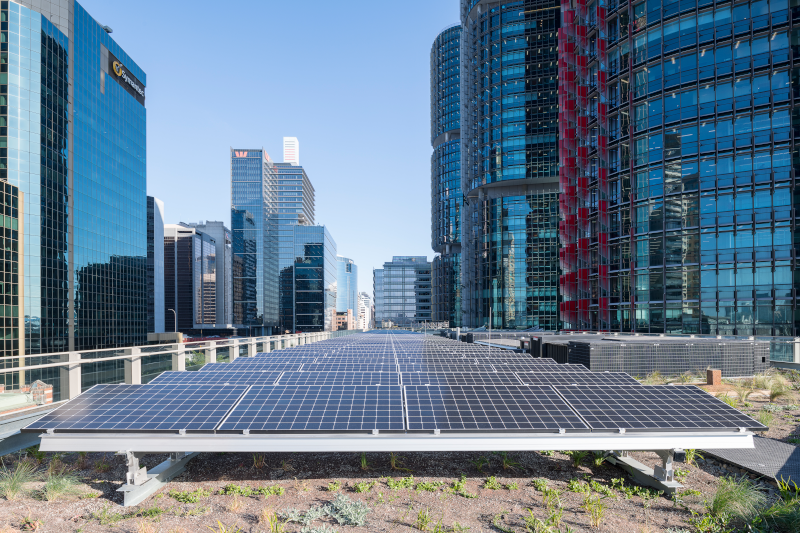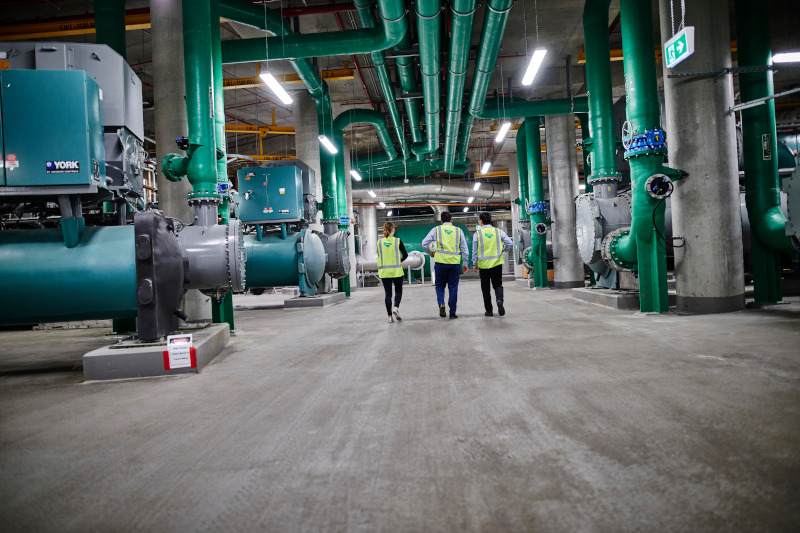Barangaroo's New Buzzing Community Helping To Reduce Carbon Footprint One Rooftop At A Time
- 20 May 2021
- by
- Lendlease Podium
It’s all abuzz atop Sydney’s Daramu House, where native and honey bees call Barangaroo home. In fact, the hive of activity - above Australia’s first commercial multi-storey timber office building - centres around purpose-built ‘Insect Hotels’ and plants selected for to support biodiversity.
As part of the sustainability measures, the ‘Insect Hotels’ - made from logs and branches join thousands of carefully selected year-round flowering plants that are known to attract pollinators. It’s a positive conservation measure that’s driving Lendlease’s sustainability and environmental targets in an effort to help reduce the carbon footprint.
On #WorldBeeDay, we celebrate our hard-working little pollinators and sit down with Monica Graham, General Manager – Origination, Podium Asset Services , to learn how Lendlease has enabled Barangaroo’s new buzzing community to thrive.
Firstly, why bees?
At Lendlease, we’re very focussed on the places we create. The Barangaroo team wanted to put plants and flowers on top of Daramu House and integrate the plantings with a solar PV system.
The team then decided to take it a step further and design the installation to support biodiversity and all importantly - bees.
Bees are so important for humans and play a part in every aspect of the ecosystem. Their ability to pollinate so that crops can thrive is truly remarkable. Bees, and other pollinators, pollinate over three quarters of plants that produce around 90% of the world’s food. They are renowned for providing high-quality food such as honey, royal jelly and other products used in healthcare such as beeswax and propolis.
It will have detrimental effects to our ecosystems if bees become extinct and there is plenty of evidence that bee populations are under enormous stress and are in decline. We could lose the plants that bees pollinate, and the animals that eat those plants may no longer have that type of food available – these are just some examples of what could happen to the food chain.

Happy World Bee Day 2021
How did the idea to create ‘Insect Hotels’ on the rooftop come about?
As cities become denser and populations increase, we need to be smarter with the way we design and use spaces. This one roof at Damaru House is a perfect example. Instead of just installing solar panels, we integrated a green roof. And not just any green roof – one designed specifically to support bees and pollinators. And it’s been very successful. Go up on the roof now and there are bees everywhere – native and honeybees. We have also partnered with UTS researchers who are testing the theory that greenery with solar panels keeps the rooftop temperature close to 25 degrees on hot days to maximise the efficiency of the solar panels.
However, in order to make space for all of this, we needed to find an alternative approach to traditional cooling systems. In conventional designs, the heat absorbed from a building by its cooling systems is put back into the atmosphere via rooftop cooling towers. These take up valuable roof space that could otherwise be used for environmental purposes. Cooling towers also use a significant amount of drinking water to perform their function.
By creating an underground District Cooling Plant (DCP) with harbour heat rejection, we were able to remove the need to install cooling towers on the rooftop. This enabled us to saturate the rooftop with 6,000 sqm of solar panels that provide green energy for the precinct, and now ample space for the ‘Insect Hotels’ for the thriving new bee population.
Rooftop of Daramu House, Sydney, Australia
Can you tell us more about the underground District Cooling Plant (DCP) at Barangaroo?
The District Cooling Plant (DCP) at Barangaroo takes advantage of its location and absorbs the heat from every building in the precinct. It then transfers the heat to Sydney’s vast harbour where it is gently released into the atmosphere through the natural oceanic evaporation process.
The DCP system in operation at Barangaroo is not typically common – or in use – across Australia. Large, centralised cooling plants connecting multiple buildings do exist in campus locations such as hospitals and universities; however, these are generally single land title site installations owned and operated by the faculty for the faculty.
Barangaroo differs, not just in its size (72MW at completion), but also in the fact it is a privately owned commercially viable energy utility providing cooling services across title boundaries. Not only does this provide more efficient energy, it removes the burden of maintaining and replacing chillers and cooling towers for each building owner.
Instead of designing individual infrastructure for each building, Podium Asset Services took the plant, services and systems for nine buildings at Barangaroo and designed them as ‘one system,’ which is housed in a basement. In fact, the 77,000 sqm basement is almost as large as one of the 42-storey office towers that sits above it and provides Barangaroo offices, apartments and retailers with power, cooling, heating and water.
Barangaroo District Cooling Plant, Sydney, Australia
Are the bees helping Barangaroo lead the green charge? What other sustainability projects are in place?
Barangaroo has been officially certified as Australia’s first carbon neutral precinct and will continue to be certified carbon neutral in operation each year moving forward. Additional sustainability targets include targeting net zero waste emissions and net positive water capability. The bees, among other initiatives, are certainly helping to lead the green charge.
We’re also experimenting with maggots in the basement of Barangaroo to help manage the food waste generated from the precinct each month, and to cut down on carbon emissions. We have partnered with GoTerra for this ground-breaking project. GoTerra have pioneered the use of native Black Soldier flies – with state-of-the-art technology, to allow us to process our food waste onsite. The maggots are capable of eating through 5 tonnes of food waste daily to transform that waste into high protein animal feed and fertiliser.
By minimising energy consumption within the precinct, maximising solar energy generation where possible, and finally offsetting the remaining carbon liability with carbon offsets, we have achieved our carbon neutral targets.
Barangaroo also has ambitious social sustainability targets to deliver 50 social programs for the precinct which support our integrated arts, education and place activation plans. Together, these plans, with the support of our tenants, workers, and residents and through the Barangaroo South Community Partnership, will ensure we create a strong and connected community for the future.
Any last words?
As an industry, we need to start implementing more innovative measures – like integrated solar and green, biodiverse rich roofs and the underground District Cooling Plant – into our design practices. It’s the cumulative effect that will produce the greatest reduction in carbon across the globe and unlock a sustainable future for us, and for generations to come.
We all have a role to play. Even the smallest of creatures, and the smallest of sustainability measures, can have a big impact – and we’re already seeing that at Barangaroo.
